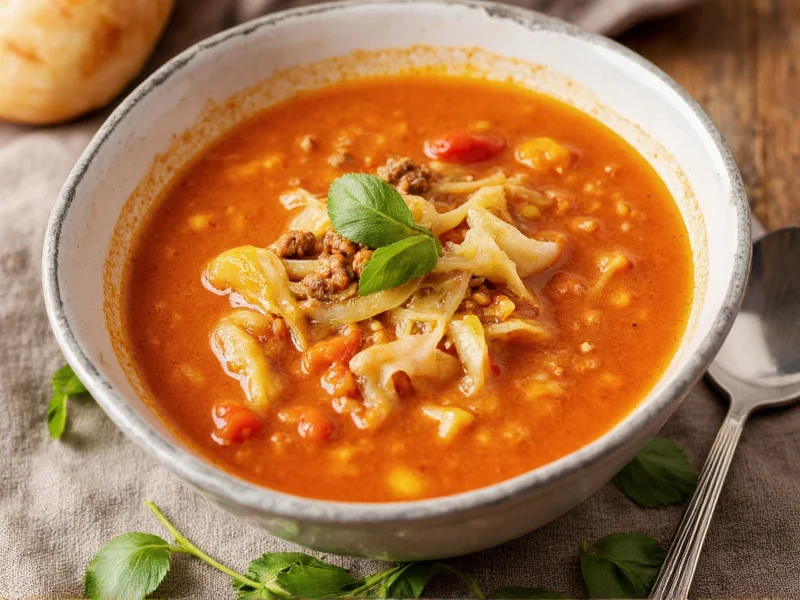The Cultural Heart of Polish Cabbage Soup
Polish cabbage soup represents more than just sustenance—it embodies generations of culinary tradition. In Poland, this comforting dish appears on tables during major holidays, family gatherings, and everyday meals. The soup's versatility allows it to transform from a simple peasant meal to an elegant holiday centerpiece depending on ingredients and preparation.
Historically, cabbage became central to Polish cuisine due to its exceptional storage properties. Before modern refrigeration, families relied on fermented cabbage (sauerkraut) to provide essential nutrients throughout harsh winters. This practical preservation method evolved into beloved culinary traditions that continue today.
Traditional Ingredients and Their Significance
Authentic Polish cabbage soup requires specific components that create its distinctive flavor profile. While regional variations exist across Poland, certain elements remain consistent in traditional preparations.
| Core Ingredient | Traditional Source | Flavor Contribution |
|---|---|---|
| Sauerkraut | Homemade fermented cabbage | Tangy base with complex umami notes |
| Smoked Pork Hock | Polish źwórczyna wędlana | Rich smokiness and gelatinous texture |
| Kielbasa | Traditional Polish sausage | Garlic and pepper notes |
| Bay Leaves | Fresh or dried | Earthy depth and aroma |
Mastering Authentic Preparation Techniques
Creating genuine Polish cabbage soup requires patience and attention to detail. The traditional method involves multiple stages that develop layers of flavor impossible to achieve through quick cooking.
Begin by rinsing sauerkraut thoroughly to remove excess brine, then squeeze out excess liquid. For the most authentic Polish cabbage soup with smoked meat, simmer pork hocks in water for 1.5 hours before adding the sauerkraut. This creates a rich broth foundation. Add kielbasa, onions sautéed in butter, and spices. The soup should simmer gently for at least 2 hours—longer cooking times produce more complex flavors.
Many Polish families follow the traditional Polish cabbage soup recipe passed down through generations, which includes a secret step: adding a small amount of mushroom broth or dried wild mushrooms for depth. This technique creates the distinctive umami richness characteristic of restaurant-quality Żurek kapuściak.
Regional Variations Across Poland
Poland's diverse regions each contribute unique interpretations of cabbage soup. In Silesia, cooks often add tomato paste for a slightly sweeter profile. Coastal regions incorporate fish or seafood in some variations. The Podhale region near the Tatra Mountains creates a heartier version with added potatoes and smoked cheese.
For those seeking a vegetarian Polish cabbage soup option, many families prepare a meatless version during religious fasting periods. This adaptation uses mushroom broth, smoked paprika, and liquid smoke to replicate the traditional smokiness without meat products. The Christmas Eve version, served without animal products, represents one of Poland's most cherished culinary traditions.
Serving Traditions and Modern Adaptations
Traditional Polish cabbage soup always appears with specific accompaniments. A dollop of sour cream provides creamy contrast to the tangy broth. Rye bread, particularly żołty żegierski, offers the perfect vehicle for soaking up every flavorful drop. Some families add a splash of vinegar or lemon juice just before serving to brighten the flavors.
Modern home cooks have developed time-saving techniques for preparing Polish cabbage soup without sacrificing authenticity. Using high-quality store-bought sauerkraut (look for naturally fermented varieties without preservatives) can produce excellent results. The key to perfect Polish cabbage soup consistency lies in the final 30 minutes of cooking—this allows flavors to meld while maintaining distinct ingredient textures.
Nutritional Benefits of Traditional Preparation
Beyond its comforting qualities, authentic Polish cabbage soup offers significant nutritional advantages. Fermented cabbage provides probiotics that support gut health. The long cooking process breaks down tough fibers, making nutrients more bioavailable. Traditional recipes balance protein from smoked meats with vitamins from cabbage and other vegetables.
For health-conscious cooks, understanding how to make Polish cabbage soup healthier remains possible without compromising flavor. Using leaner cuts of meat, increasing vegetable content, and reducing sodium while maintaining traditional preparation methods preserves both nutritional value and authentic taste.











 浙公网安备
33010002000092号
浙公网安备
33010002000092号 浙B2-20120091-4
浙B2-20120091-4